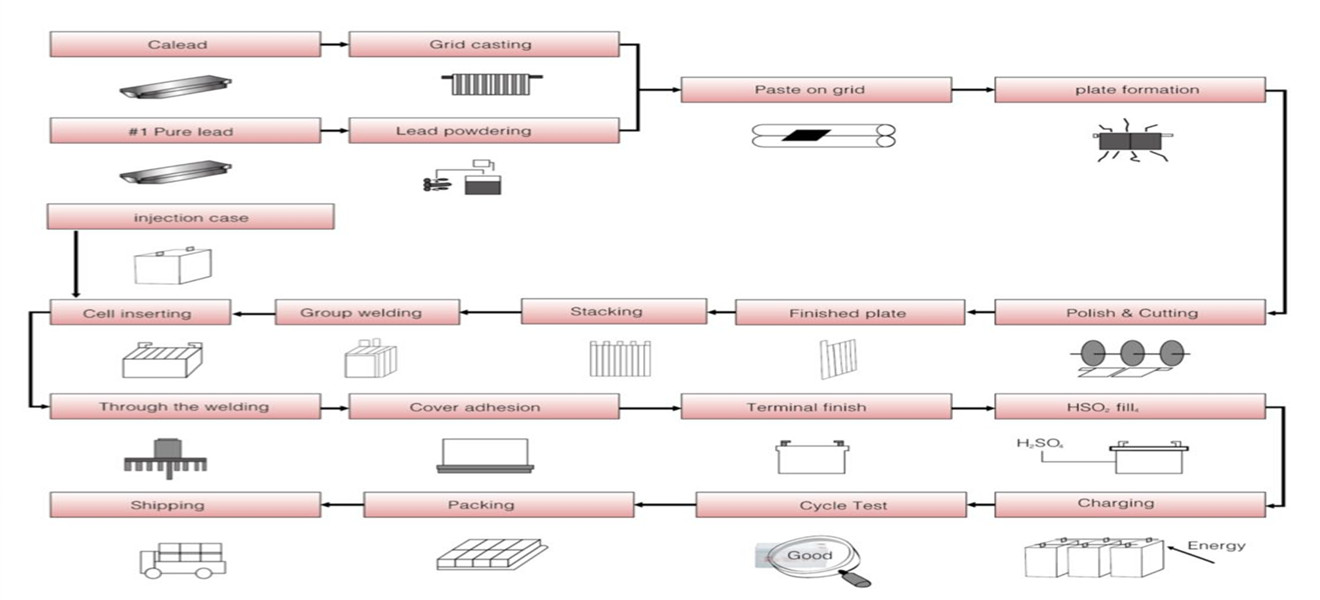
What is a lead_acid battery?
A lead-acid battery has electrodes mainly made of lead and lead oxide, and the electrolyte is a sulfuric acid solution. When a lead-acid battery is discharged, the positive plate is mainly lead dioxide, and the negative plate is lead. The lead sulfate is the main component of the positive and negative plates when charging.
The nominal voltage of a single-cell lead-acid battery is 2V, which can be discharged to 1.5V and charged up to 2.4V. In applications, 6 single-cell lead-acid batteries are often connected in series to form a nominal 12V lead-acid battery. It can also be designed into 24V, 36V, and 48V batteries.
What is the structure of lead-acid battery?
To enable the battery to be sealed, in the VRLA battery, a part of the electrolyte is absorbed in the plate and separators, thereby increasing the oxygen absorption capacity of the negative electrode and preventing the loss of electrolyte. VRLA battery is mainly composed of the positive plate, negative plate, separator, electrolyte, case, valve, and terminal.
Positive and negative plate: The positive plate is a lead-antimony-calcium alloy grid containing lead oxide as an active material. The negative plate is a lead-antimony-calcium alloy grid composed of spongy fiber active material. It can ensure that the battery has sufficient capacity, and the battery capacity in long-term use can reduce battery self-discharge.
Separator: Advanced microporous AGM separator, which can hold the electrolyte, prevent the short circuit between the positive plate and the negative plate, and prevent the active material from falling off the plate surface.
Electrolyte: In the battery’s electrochemical reaction, sulfuric acid acts as an electrolyte to conduct ions so that electrons can be transferred between the positive and negative active materials of the battery.
Case and cover: Unless otherwise specified, the case and cover are ABS resin. Provide space for battery positive and negative combination fences.
Valve: The material is synthetic rubber with high-quality acid resistance and anti-aging. When the battery’s internal pressure is higher than the normal pressure, the gas is released to keep the force regular and prevent the entry of oxygen.
Terminals: With the difference, the positive and negative terminals can be tabs, rods, studs, or lead wires. Hermetically sealed terminals facilitate high current discharge and extend battery life.
Lead Acid Battery Manufacturing Process Flow Chart
JYC BATTERY is a Lead Acid Battery Manufacturer, and the follow is JYC Lead Acid Battery Production Process
Lead Acid Battery Manufacturing Process
Lead powder manufacturing
The lead powder machine, special equipment for electrolytic lead, is made into a lead powder that meets the requirements through oxidation screening. The first is to cut qualified lead bars into lead balls or lead segments; the second step is to put the lead balls or display details into the lead powder machine, and the lead balls or lead components are oxidized to form lead oxide; Put it into the designated container or powder storage bin; Then it can be used, after aging for 2-3 days and passing the test. When making lead powder, it is necessary to control the degree of oxidation, apparent density, water absorption, and particle size.
Grid casting
The lead-antimony alloy, lead-calcium alloy, or other lead alloys are made by continuous casting to meet the requirements of the grid. The grid is the active material carrier and the conductive current collector. Ordinary open battery grids are generally cast with lead-antimony alloys, maintenance-free battery grids are usually released with low antimony alloys or lead-calcium alloys, and sealed valve-regulated lead-acid battery grids are usually cast with lead-calcium alloys.
The first step of making the grid is determining the type of alloy lead according to the battery type and putting it into the lead furnace for heating and melting. After meeting the process requirements, the lead liquid is cast into the metal mold. After cooling, the lead mold is trimmed and placed neatly; the second step is cutting. After a certain period, the grid can enter the subsequent production process. During this process, the quality of the grid, thickness, size, and integrity are controlled.
Plate manufacturing
After mixing lead powder, dilute sulfuric acid and additives, smear it on the surface of the grid and then dry and solidify it, that is, the unformed plate. The plate is the core part of the battery, and its quality directly affects various performance indicators of the battery. The first step in the production of paste-coated plates is to use special equipment for testing qualified lead powder, dilute sulfuric acid, and additives to make a lead paste; in the second step, the lead paste is filled on the grid with a smear machine or by hand; The third step is to solidify and dry the filled plate to obtain a unformed plate.
Plate formation
The positive and negative plates used in battery assembly refer to the positive and negative plates formed by a redox reaction with dilute sulfuric acid under the action of direct current to generate lead oxide, and then cleaned and dried. Plate formation and battery inner formation are different methods in the battery manufacturing process, which can be selected according to specific conditions. The formation of polar plates is relatively easy to control, but the cost is high, and it requires special treatment for environmental pollution problems. The quality control of battery inner formation is complex, and the quality of the unformed plates produced is relatively high, but the cost is relatively low. The first step in forming a sealed valve-regulated lead-acid battery is to put the qualified unformed plates into the battery tank for sealing according to the process requirements; the second is to pour a certain concentration of dilute sulfuric acid into the battery according to the specified amount. Third, after being placed, a direct current is applied according to the size of the specification. After forming, it needs to be checked for discharge and then assembled and put into storage to prepare for delivery.
Assemble the battery
Assemble different types of plates with other numbers in different kinds of batteries according to different needs. There is a big difference between the assembly of automotive batteries and sealed VRLA batteries. Sealed VRLA batteries require tight assembly and AGM separators, while automotive batteries generally use PE, PVC, or rubber separators. The first assembly step is to load the qualified polar plate into the welding tool according to the process requirements. The second step is to put the cast and welded polar groups into a clean battery case. Car batteries must be welded through the wall and heat-sealed, while sealed VRLA batteries are bonded with ABS battery case and special adhesives.
9 major processes in the production of JYC lead acid battery products:
(1) Lead powder and cast alloy grid:The lead powder is the primary raw material for making battery plate active material. The qualified lead bars are cut into lead pellets filled in the ball mill, and through the rotating drum, the lead balls fall under the action of their gravity, collide with each other, and rub into powder. The grid is the skeleton of the plate, the carrier of current conduction, and the adhesion of active substances so that the current passing through the plate is evenly distributed.
(2) Mixing: The combined paste is a paste-like substance formed by mixing lead powder, water, sulfuric acid solution, and additives uniformly by mechanical stirring. A mixture of basic lead sulfate, oxide, and free lead is produced in a certain shape and proportion. The quality of the paste directly affects the capacity and life of the battery. Apply the mixed lead paste on the alloy grid, compact, and pour acid. After the dry surface, make the grid and the lead paste tightly combined, and the surface is free of defects and cracks. After this step, the wet unformed plate is formed.
(3) Plate formation:The curing principle is to make the wet raw plate after drying on the surface, under the conditions of controlling relative temperature, humidity, and time, to make the wet raw plate lose moisture. The unformed plate is fully oxidized and corroded to form a plastic active substance, condensed into a solid substance with uniform pores.
(4) Polish&cutting:Divide the large scale into plates of the shape and size required by the process by cutting
(5) Plate wrapping:This is a process of energy distribution, which is a process of combining positive plates, negative plates, and separators into a plate separator body according to the specified number of leaves and the order of the plate direction.
(6) Equipment: Connect the positive and negative plate of the grid plate by casting and welding, respectively. After launching and welding, the semi-finished battery with a protective mesh is placed on the top of each single-grid plate group, and a certain amount of epoxy is placed upside down. In the middle cover groove of the resin, adhere the battery bottom case to the central cover, weld the terminals, and apply colored glue to distinguish the positive and negative plate.
(7) Add acid: Add a rated amount of electrolyte to each battery cell by vacuum negative pressure.
(8) Battery inner formation is the process of turning unformed plates into mature plates. The acid solution reacts with the plates to identify the quality of the battery. Connect the specified number of batteries in series, charge, and discharge according to the process, activate the battery, and make the positive and negative active materials form a certain amount of lead dioxide and spongy lead.
(9) Packaging: Print the trademark of the charged battery and pack it in a box.





One Comment
Thanks for finally talking about > Advanced Manufacturing Process Of Lead-acid Battery < Loved it!
Comments are closed.